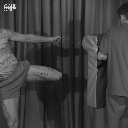Soft tissue motion during impact
 This research aims to look at violent impacts and the kinetics of such
impacts with a view to their potential to cause injury. In these cases
non-rigid body motion is obvious and contributes to the overall injury
potential and patterns. As a first step the effects that incorporating
the motion of the soft tissue of a body segment relative to each limb
segment would have on the gross kinetics of the whole system via a wobbling
mass model was examined. To this end, a combination of tissue mechanical
properties, in vivo soft tissue motion, and behaviour of wobbling mass
models needed to be studied. Measurements were taken of the soft tissue
of body segments while they underwent impacts with different muscular
tensions. An array of 28 surface markers was used to examine the magnitude
and frequency content of the marker motion. A 2-D wobbling mass model
was developed to simulate landing from a drop. Subject specific anthropometric
parameters were calculated for both the rigid links and the wobbling masses.
Magnitude and frequency response of the soft tissue of the subject to
impulsive loading was measured and used as a control for the wobbling
mass motion. The model successfully reproduced the vertical ground reaction
force for the first 80 ms of the landing and demonstrated a marked decrease
in joint reaction forces and torques over a rigid body model. When examining
human impacts the influence of intra-segmental soft tissue motion should
not be ignored as it significantly changes the kinetics of the system.
The selection of the human-environment interface needs to be carefully
chosen in light of the model that is used so as not to reproduce or exclude
force-producing elements.
This research aims to look at violent impacts and the kinetics of such
impacts with a view to their potential to cause injury. In these cases
non-rigid body motion is obvious and contributes to the overall injury
potential and patterns. As a first step the effects that incorporating
the motion of the soft tissue of a body segment relative to each limb
segment would have on the gross kinetics of the whole system via a wobbling
mass model was examined. To this end, a combination of tissue mechanical
properties, in vivo soft tissue motion, and behaviour of wobbling mass
models needed to be studied. Measurements were taken of the soft tissue
of body segments while they underwent impacts with different muscular
tensions. An array of 28 surface markers was used to examine the magnitude
and frequency content of the marker motion. A 2-D wobbling mass model
was developed to simulate landing from a drop. Subject specific anthropometric
parameters were calculated for both the rigid links and the wobbling masses.
Magnitude and frequency response of the soft tissue of the subject to
impulsive loading was measured and used as a control for the wobbling
mass motion. The model successfully reproduced the vertical ground reaction
force for the first 80 ms of the landing and demonstrated a marked decrease
in joint reaction forces and torques over a rigid body model. When examining
human impacts the influence of intra-segmental soft tissue motion should
not be ignored as it significantly changes the kinetics of the system.
The selection of the human-environment interface needs to be carefully
chosen in light of the model that is used so as not to reproduce or exclude
force-producing elements.
Publications
- Pain, M.T.G. and Tsui, F and Cove, S., 2008. In vivo determination of the effect of shoulder pads on tackling forces in rugby, Journal of Sports Sciences, 26 (8), 75 – 82.
- Challis, J.H. and Pain, M.T.G. 2008. Soft tissue motion influences skeletal loads during impacts. Exercise and Sports Science Reviews, 36 (2), 71-75.
- Pain, M.T.G. and Challis, J.H. 2006. The influence of soft tissue movement on ground reaction forces, joint torques and joint reaction forces in drop landings. Journal of Biomechanics 39, 119-124.
- Pain, M.T.G. and Challis, J.H. 2004. Wobbling mass influence on impact ground reaction forces: a simulation model sensitivity analysis. Journal of Applied Biomechanics 20, 309-316.
- Pain, M.T.G. and Challis, J.H. 2002. Soft tissue motion during impacts: their potential contribution to energy dissipation. Journal of Applied Biomechanics 18, 231-242.
- Pain, M.T. and Challis, J.H. 2001. The role of the heel pad and shank soft tissue during impacts: A further resolution of a paradox. Journal of Biomechanics 343, 327-333.
Return to Impact page →
